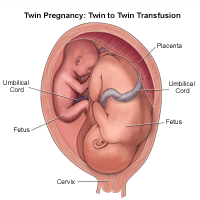Complications of Multiple Pregnancy
Why is multiple pregnancy a concern?
Being pregnant with more than one baby is exciting and is often a happy event for many couples. However, multiple pregnancy has increased risks for complications. The most common complications include the following:
-
Preterm labor and birth
Over 60 percent of twins and nearly all higher-order multiples are premature (born before 37 weeks). The higher the number of fetuses in the pregnancy, the greater the risk for early birth. Premature babies are born before their bodies and organ systems have completely matured. These babies are often small, with low birthweights (less than 2,500 grams or 5.5 pounds), and they may need help breathing, eating, fighting infection, and staying warm. Very premature babies, those born before 28 weeks, are especially vulnerable. Many of their organs may not be ready for life outside the mother's uterus and may be too immature to function well. Many multiple birth babies will need care in a neonatal intensive care unit (NICU).
-
Gestational hypertension
Women with multiple fetuses are more than twice as likely to develop high blood pressure of pregnancy. This condition often develops earlier and is more severe than pregnancy with one baby. It can also increase the chance of placental abruption (early detachment of the placenta).
-
Anemia
Anemia is more than twice as common in multiple pregnancies as in a single birth.
-
Birth defects
Multiple birth babies have about twice the risk of congenital (present at birth) abnormalities including neural tube defects (such as spina bifida), gastrointestinal, and heart abnormalities.
-
Miscarriage
A phenomenon called the vanishing twin syndrome in which more than one fetus is diagnosed, but vanishes (or is miscarried), usually in the first trimester, is more likely in multiple pregnancies. This may or may not be accompanied by bleeding. The risk of pregnancy loss is increased in later trimesters as well.
-
Twin-to-twin transfusion syndrome
Twin-to-twin transfusion syndrome (TTTS) is a condition of the placenta that develops only with identical twins that share a placenta. Blood vessels connect within the placenta and divert blood from one fetus to the other. It occurs in about 15 percent of twins with a shared placenta.
In TTTS, blood is shunted from one fetus to the other through blood vessel connections in a shared placenta. Over time, the recipient fetus receives too much blood, which can overload the cardiovascular system and cause too much amniotic fluid to develop. The smaller donor fetus does not get enough blood and has low amounts of amniotic fluid.
 |
| Click Image to Enlarge |
-
Abnormal amounts of amniotic fluid
Amniotic fluid abnormalities are more common in multiple pregnancies, especially for twins that share a placenta.
-
Cesarean delivery
Abnormal fetal positions increase the chances of cesarean birth.
-
Postpartum hemorrhage
The large placental area and over-distended uterus place a mother at risk for bleeding after delivery in many multiple pregnancies.
© 2000-2025 The StayWell Company, LLC. All rights reserved. This information is not intended as a substitute for professional medical care. Always follow your healthcare professional's instructions.